The Forts of Verdun - Part 4
Back to Part One
Back to Part Two
Back to Part Three
Part VI - Epilogue, 1995
I made an all-too-brief visit to Verdun in 1995. The first thing
that struck me about the area was the pine
forests. The trees cover almost the entire battle area.
I have heard that they are the only thing that will grow in
the still-poisoned soil. Poisoned by chemical warfare agents
and decayed bodies.
 ____
____
Typical Verdun-type terrain, seen in 1918.
When I looked among the
pines I saw an endless up-and-down terrain. This was formed by
the smaller shell craters.
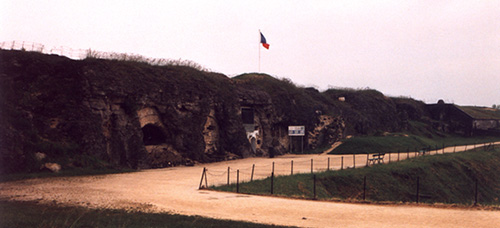
Entrance to Ft. Douaumont today.
As I approached
Fort Douaumont, a black crow flew off the road behind me. I've
heard that even the birds shun the forts now.
Despite recent rains in June, the grass on top of the fort was half
green, half yellow. The 155mm and 75mm
turrets are still intact. In fact, the forts of Verdun were extensively
refurbished under the Maginot Line program.
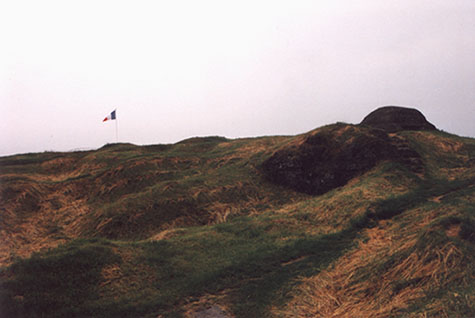
Above the collapsed tunnel at Ft. Douaumont.
On top, you can see the 8' sheared concrete where the main tunnel collapsed.
The rear entrance area consists
of extensively blasted concrete with some crude patching and a number
of doors and windows.
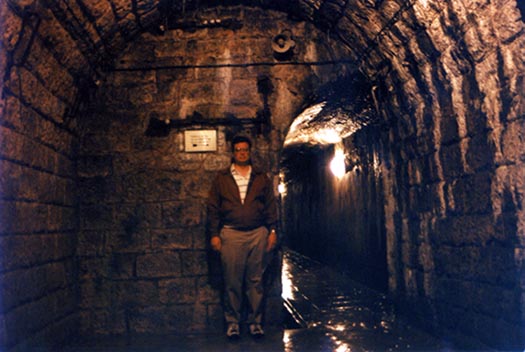
In the main tunnel of the fort.
Inside, it is cool
and damp. There are 2-man bunks in the barracks rooms.
The stove is still there. A wooden cross is tucked
under a burner; presumably someone was killed in the room. A
memorial to the 400 dead Germans who lie
entombed in the fort is painted on the wall where the collapsed tunnel
has been neatly finished as a dead end.
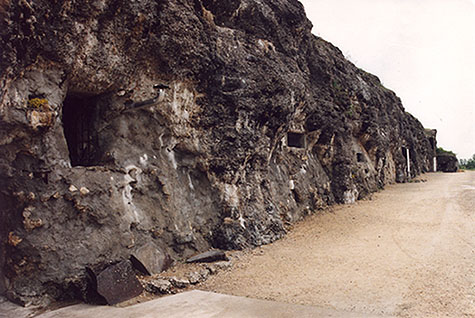
The rear of Ft. Vaux today.
Fort Vaux was given a new 75mm turret under the Maginot Line program.
The ring of the original one is some distance behind
the new one, tilted at a crazy angle.
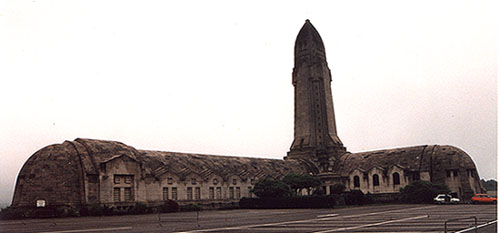
The Ossuary at Douaumont.
The Ossuary at Douaumont (actually near the site of Thiaumont) is a
grim reminder of the battle, adjacent to the
French cemetery and surrounded by various monuments. It has three main vaults with rounded
ends, which have slots to resemble pillboxes. A tall
central tower dominates the structure. It was built by contributions
from all the Allied nations, on some of the
most fought-over ground of the battle. Underneath it lie the
remains of 150,000 Germans and Frenchmen,
collected from all over the area. On the curved walls of the
vaults are carved the names of the French missing.
I followed a sign toward a memorial chapel on the site of the village
of Douaumont. I thought I might see ruins,
but there was not the slightest trace of the village itself.
Nine villages were pounded into dust in the course of
the battle. I later passed a cross-shaped memorial to the village
of Fleury, but did not stop. I knew there would be nothing else there.
The museum is a joint French and German one. It is well worth a visit to see
the equipment with which the battle
was fought. There are, of course, cemeteries of both sides throughout the battle area.

A French WW1 cemetery.

A German WW1 cemetery. There are four men per cross.
In town, a World Peace Center has been built under the Bishop's Palace courtyard, with the entrance on the
spot where the first shell hit. The exhibits express faith in
the United Nations and international agreements as
guarantors of peace. I wish their faith was more justified.
The city hall has 520mm shells out front, built for a
massive French gun that appeared too late to see action. There
is an underground citadel (Citadelle Souterraine) with a mini-train tour, as well as fortifications designed by Vauban.
Part VII - Sources
My goal has been to write a more complete account of the forts at Verdun than I have
been able to find on the
Web so far. My primary source is "The Price of Glory: Verdun 1916"
by Alistair Horne, who has a French Legion of Honour for literature. Unfortunately,
I don't have his book with me
right now, so I have written this from memory. Where I
am not sure what the facts were, I have tried to be vague rather than making up a story.
A good source on the web is
HERE, the Web page of OCRA, a French group dedicated to the study of underground
places such as forts. Much of it is "under construction". When complete it will be a
definitive treatise on Verdun and much else. A reference for the Sere de Rivieres forts is HERE
(French only).
Photos are from the
University of Kansas World War 1 Site, "American Armies and Battlefields in Europe"
(available in better libraries), "The First World War: A Photographic History" by Laurence
Stallings (hard to find), "The French Railway Gun Page", and my personal collection. A site with photos of a number of Verdun forts is Rainer's Verdun Photo Page.
E-mail the author: rob.du@verizon.net
Back to Part One
Back to Part Two
Back to Part Three
Back to The Fort Page.
 ____
____
 ____
____






